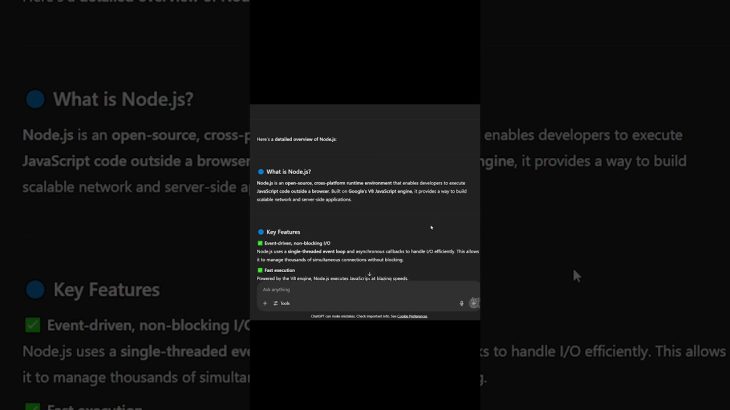🔷 What is Node.js?
Node.js is an open-source, cross-platform, JavaScript runtime environment that executes JavaScript code outside a web browser. It allows developers to build fast and scalable server-side applications using JavaScript.
Created by Ryan Dahl in 2009
Built on Google Chrome’s V8 JavaScript engine
Maintained by OpenJS Foundation
🔷 Key Highlights
FeatureDescriptionRuntimeExecutes JavaScript code on the server sideNon-blocking I/OHandles multiple requests asynchronously without waitingSingle-threadedUses a single-threaded event loop model for concurrencyCross-platformRuns on Windows, Linux, and macOSnpm (Node Package Manager)Offers access to 2M+ open-source packages
🔷 Core Architecture
Single-threaded Event Loop
Node.js uses a single thread to handle concurrent requests using an event-driven model.
V8 Engine
High-performance JavaScript engine developed by Google, compiles JS to machine code.
Libuv
Handles asynchronous operations like file I/O, networking, etc.
EventEmitter
Core module used to handle events and listeners.
🔷 Node.js Modules
Built-in Modules (e.g., http, fs, path, url)
Custom Modules (user-defined)
Third-party Modules (via npm, e.g., Express, Lodash)
🔷 Use Cases
Web servers and REST APIs
Real-time apps (e.g., chat apps, games)
Microservices
IoT applications
Command-line tools
Streaming services
🔷 Advantages of Node.js
🚀 High performance due to V8 engine
⚡ Fast I/O operations with non-blocking architecture
🌐 JavaScript everywhere – frontend and backend in one language
🔄 Scalable through event-driven architecture
📦 Rich ecosystem via npm
👨💻 Large community support
🔷 Limitations
❗ Not ideal for CPU-intensive tasks (e.g., heavy computation)
🧵 Single-threaded nature can be a bottleneck for certain use cases
🧪 Callback hell (though reduced with Promises & async/await)
🔷 Real-World Examples
Netflix – for fast, scalable streaming
LinkedIn – mobile backend
PayPal – handles millions of transactions
Uber – real-time ride matching
🔷 Conclusion
Node.js revolutionized backend development by bringing JavaScript to the server side.
It is especially powerful for building fast, scalable, and data-intensive real-time applications.
Thanks to its non-blocking architecture, event-driven model, and the massive npm ecosystem, Node.js continues to be a top choice for modern developers.














![ChatGPT + Google: ho scoperto un TRUCCO PRO GRATIS! [Tutorial]](https://chatgpt.retromanplanning.com/wp-content/uploads/2025/05/ChatGPT-Google-ho-scoperto-un-TRUCCO-PRO-GRATIS-Tutorial-730x410.jpg)